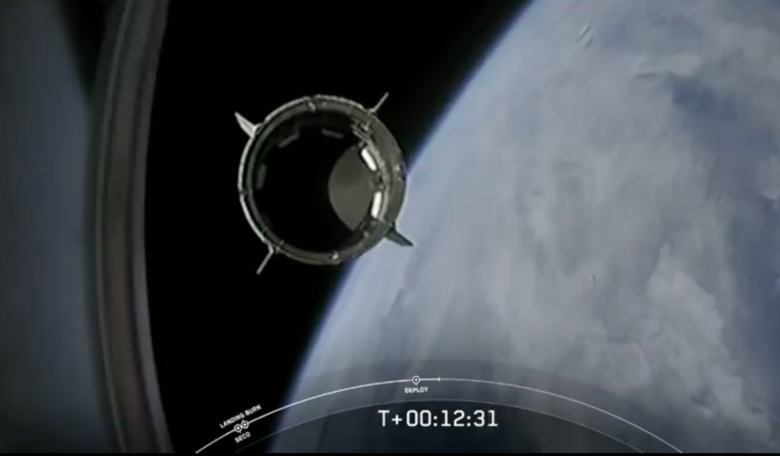30th May, 2020 will go down in spaceflight history as the day two US astronauts lifted off from US soil on a SpaceX private rocket destined for the International Space Station.
It was second time a charm for SpaceX and NASA as earlier attempts to launch on 27th May had to be scrubbed due to rain and lightning around Kennedy Space Center.
Today though, although ominous-looking clouds still lurked around the coast, the launch proceeded flawlessly. Cheers were heard throughout ground control as each critical stage of the launch was completed. None more so than when the countdown clock hit zeros around 19:22 GMT (15:22 EDT) and Falcon 9 smoothly lifted off and headed into orbit.
After around 9 minutes into launch, the Falcon 9 booster landed safely on the Of Course I Still Love You droneship using engine power so that it can be re-used on a future flight.
A few minutes later Crew Dragon separated from Falcon 9’s second stage. Once Crew Dragon has separated from the Falcon, it makes the rest of the journey to the ISS using its own thrusters.
Veteran astronauts Doug Hurley and Bob Behnken now have a 19 hour trip to the International Space Station, where current ISS inhabitants – Commander Chris Cassidy and Roscosmos cosmonauts and Flight Engineers Anatoly Ivanishin and Ivan Vagner – are eagerly awaiting to throw their new guests a welcome party when they dock at the station.
Over 10 million people watched the live stream as the launch took place, though some lucky onlookers were able to watch Falcon 9 blasting off from Florida including President Trump, who is the third sitting president to watch a live launch to the ISS.
Today’s success is the culmination of a nine year journey and although SpaceX regularly puts satellites into orbit, this is the first time it has taken people above the atmosphere.
Now that SpaceX has proven itself to be a worthy space “taxi” to ferry astronauts to low-Earth orbit, NASA is no longer reliant on Russia for trips to the ISS; an arrangement that had been in place since the retirement of the Space Shuttle programme in 2011.
The agreement, which had also seen the US space agency pay the Russian government more than $90.2 million for a single seat on a Soyuz spacecraft, is however still in place for at least the remainder of the year and until commercial crew capabilities are routinely available.
A possibility that is now within reach after the successful end to Demo-2; the final major step required by SpaceX's Crew Dragon, in order to get certified by Nasa's Commercial Crew Programme for more long-term manned missions to space.
It was the third spaceflight each for crew members Hurley and Behnken - two of Nasa's most experienced astronauts.
Hurley, who was the pilot on Atlantis, the very last space shuttle to make an outing, will be in charge of the launch, landing and recovery of the vehicle, while Behnken will serve as the mission's joint operations commander and take responsibility for the rendezvous, docking and undocking of the Dragon capsule.
Despite long established careers, launching in Crew Dragon will be a significantly different experience, as the veteran astronauts fly the vehicle by entering commands on a touchscreen rather than by using buttons and a control stick - as was the case for the space shuttle.
It is unclear at the moment how long Behnken and Hurley will spend on the orbiting outpost before coming home, but it's likely to be no longer than four months.
If you've enjoyed reading this article, please consider subscribing to ROOM Space Journal to gain immediate and full access to the latest magazine feature articles and receive your own print and/or digital copies of the quarterly ROOM magazine delivered electronically or direct to your door.











